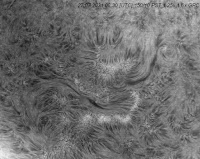*
Friday 30th. 65F, overcast and windy with showers. Again, not a day for imaging, nor outdoor woodwork.
Today I wanted to raise the new, inner shutter ribs onto the dome. The ladder was all set up and I was ready to go but it kept raining. No point in pulling the shutters off in this weather. Though I might have another go after lunch if it clears up a bit. [It remained dry after lunch.]
I'll try separating the GRP shutters by enough to slip the ribs in one at a time. If I then clamp them together they will be more stable. I need to remove the zenith profiles from all the slit cross struts to make room for these ribs.
It went quite well once I started. Off came the shutter covers onto the ground. As I have said before they are rather heavy and very flexible. I don't want to slide them down the dome for cosmetic reasons. More marks to polish out before the big lift. Trying to lower them any other way risks them cracking in half!
Then off came the zenith profiles. I lifted the inner shutter ribs into place and screwed them together for stiffness and to ensure the curves matched.
Adding packing pieces of 2x2 [50x50mm] battens to the tops of the slit cross-braces helped stabilise the ribs by friction. This also ensured the shutters would be concentric with the slit ribs and dome. BTW: The shutter ribs are temporarily screwed to the slit ribs for stiffness and location. These screws will still be accessible when the shutters are built.
Temporary, metal brackets were screwed to the packing pieces to hold the new ribs accurately central. Finally I was able to lift the shutter covers onto the resulting structure. Just to keep the rain out. Ratchet straps completed the security of the heavy GRP shutter covers overnight. It would be a disaster if they blew off and cracked across in the fall. You would not believe the effort which went into cutting them accurately out of the extra roof panel.
The fixing screws will eventually have to come out to separate the shutters but I wanted maximum rigidity. With all the ribs stabilised, by each other, I can ensure the shutters will be accurate. They will need half width, zenith profiles to act as cross ribs between the long, vertical ribs. This should help to stop them twisting on their axes.
Stiffness is important to ensure that each shutter moves as one unit without flexure. This is a requirement if the shutters are to close neatly against each other when pushed sideways at the bottom. Flexure demands quite a long pole to close the shutters. Not desirable in a sudden downpour!
Nor is it desirable to have such long objects in the dome. They are difficult to store and could cause damage to the equipment if they fell over. My plywood dome has a problem of detachment at the top corner of one shutter. I need a long pole to push the shutters tightly together at the top. The pole is an absolute nuisance! It usually lies across the floor or against the stepladder. The potential damage to the bulky telescopes while wielding the pole is a serious worry.
The shutters could have opposing pulleys and ropes to close them at the top. However, the dangling ropes would need to be fed down through screwed eyes to keep them tidy. I already have problems with the [OTA hoist] pulley ropes in the plywood dome.
I use screw hooks for those but they are always out of reach if a loop should slip off during dome rotation. Which means fetching the stepladder and swinging the telescopes out of the way. The fibreglass dome has no useful ribs to which to attach anything. Drilling a series of holes would invite leakage! Fitting eye-bolts would have to be done before the lift and using rubber washers as gaskets. Any ropes would have to run down the plywood, slit ribs.
You can't have ropes dangling down inside the dome. Because the telescopes would constantly get tangled in them. You have to remember that the dome base ring is at eye level once it is mounted on its rotation rollers. So the entire dome rises above that level. The top will be somewhere around 4m [well over 12'] above the observatory floor. With the new dome down on the ground I still have to stand on the top rungs of a builder's folding stepladder. Just to reach out through the slit.
________________________________________
The long delayed, Russian module accidentally ignited its engines while newly attached to the International Space Station. The ISS veered and lost height until the crew regained control.
*


























































